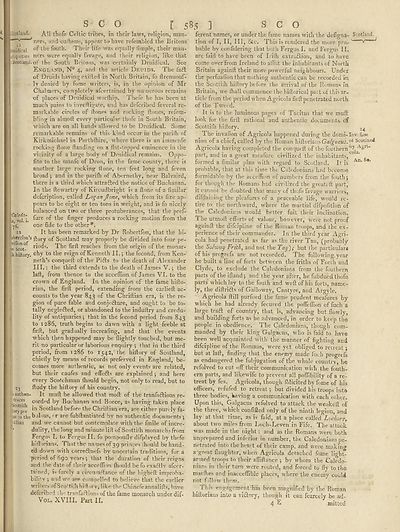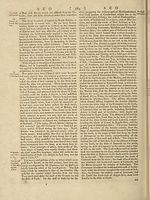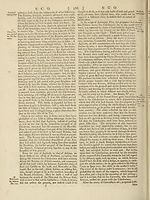Encyclopaedia Britannica, or, a Dictionary of arts, sciences, and miscellaneous literature : enlarged and improved. Illustrated with nearly six hundred engravings > Volume 18, RHI-SCR
(623) Page 585
Download files
Complete book:
Individual page:
Thumbnail gallery: Grid view | List view

iCotland.
ruidical
S c ° [ 585
All tliefe Celtic tribes, In their laws, religion, man¬
ners, and cuftoms, appear to have refembled the Britons
of the fouth. Their life was equally fimpie, their man-
itiqaities ners were equally favage, and their religion, like that
Scotland, of the South Britons, was certainly Druidical. See
England, N° 4, and the article Druids. The fa£t
of Druids having exifted in North Britain, fo flrenuouf-
ly denied by feme writers, is, in the opinion of Mr
Chalmers, completely afeertained by nu nerous remains
of places of Druidical worfhip. Thefe he has been at
much pains to inveftigate, and has deferibed feveral re¬
markable circles of Hones and rocking Hones, refem-
bling in almoH every particular thofe in South Britain,
which are on all hands allowed to be Druidieal. Some
remarkable remains of this kind occur in the parifh of
Kirkmichael in Perthlhire, where there is an immenfe
rocking Hone Handing on a flat-topped eminence in the
Cafedo-
a, vol. i.
76.
vicinity of a large body of Druidical remains. Oppo-
lite to the manfe of Dron, in the fame countv, there is
another large rocking Hone, ten feet long and feven
broad ; and in the parifh of Abernethy, near Balvaird,
there is a third which attrafted the notice of Buchanan,
In the Hewartry of Kircudbright is a Hone of a fimilar
defeription, called Logan Jlone, which from its fize ap¬
pears to be eight or ten tons in weight, and is fo nicely
balanced on two or three protuberances, that the pref-
fure of the finger produces a rocking motion from the
one fide to the other*.
It has been remarked by Dr Robertfon, that the hi-
abenfon’s Hory of Scotland may properly be divided into four pe¬
te Scot- The firfi reaches from the origin of the monar-
1, hiftory. chy to the reign of Kenneth II.; the fecond, from Ken¬
neth’s conquefi of the Pi£ls to the death of Alexander
III.: the third extends to the death of James V.; the
lafi, from thence to the accefiion of James VI. to the
crown of England. In the opinion of the fame hiflo-
rian, the firfl period, extending from the carliefl ac¬
counts to the year 843 of the ChriHian era, is the re¬
gion of pure fable and conjedlure, and ought to be to¬
tally negle&ed, or abandoned to the induHry and credu¬
lity of antiquaries; that in the fecond period from 843
to 1286, truth begins to dawn with a light feeble at
firfi, but gradually increafing, and that the events
which then happened may be flightly touched, but me¬
rit no particular or laborious enquiry ; that in the third
period, from 1286 to 1542, the hifiory of Scotland,
chiefly by means of records preferved in England, be ¬
comes more authentic, as not only events are related,
but their caufes and effedfs are explained ; and here
every Scotchman fhould begin, not only to read, but to
ftudy the hifiory of his country,
jauthan- It mufi be allowed that mofi of the tranfa&ions re-
icottifli corc*e(* ky Buchanan and Boece, as having taken place
:ory pie Scotland before the ChriHian era, are either purely fa¬
ns t0 the balms, cr are fubfiantiated by no authentic documents;
iitian and we cannot but contemplate with the fmile of incre-
• dulity, the long and minute lifi of Scottifh monarchs from
Fergus I. to Fergus II. fo pompoufly difplayed by thefe
hifiorians. That the names of 39 princes fhouid be hand¬
ed down with corre&nefs by uncertain traditions, for a
period of 690 years; that the duration of their reigns
and the date of their acceflion fhould be fo exaftly afeer¬
tained, is furely a circumfiance of the highefi improba¬
bility ; and we are compelled to believe that the earlier
writers ofScofti(lihifiory, like the Chinefeannalifts, have
deferibed the tranfaftions of the fame monarch under dif-
Vol. XVIII. Part II.
23
An. S*,
] SCO
ferent names, or under the fame names with the defigna- Scotland,
tion of I, II, III, &o. This is rendered the more pro- ' r"i
bable by eonfidering that both Fergus I. and Fergus II.
are faid to have been of Irifh extnuRion, and to have
come over from Ireland to affilt the inhabitants of North
Britain againft their more powerful neighbours. Under
the perfuafion that nothing authentic can be recorded in
the Scottifh hiftory before the arrival of the Romans in
Britain, we (ball commence the biftorical pait of this ar¬
ticle from the period when Agricola firft penetrated north
of the Tweed.
It is to the luminous pages of Tacitus that we mufi:
look for the firfi: rational and authentic documents, of
Scottifh hiftory. 2i.
The invafion of Agricola happened during the domi-Inv; (Um
nion of a chief, called by the Roman hiftoriansGfl/ftfCtt.r.ot Scotland
Agricola having completed the eonqueft of the fouthern ^ ^n"
part, and in a great meafure civilized the inhabitants, “
formed a fimilar plan with regard to Scotland. It is
probable, that at this time the Caledonians had become
formidable by the accefiion of numbers from the fouth;
for though the Romans had civ.Tzid the greateft part,
it cannot be doubted that many of thofe favage warriors,
difdaining the pleafures of a peaceable life, would re¬
tire to the northward, where the martial difpofition of
the Caledonians would better fuit their inclination.
The utmoft efforts of valour, however, were not proof
againft the difeipline of the Roman troops, and the ex¬
perience of their commander. In the third year Agri¬
cola had penetrated as far as the river Tau, (probably
the Solway Frith, and not the Tay); but the particulars
of his progrefs are not recorded. The following year
he built a line of forts between the friths of Forth and
Clyde, to exclude the Caledonians from the fouthern
parts of the ifland; and the year after, he fubdued thofe
parts which lay to the fouth and weft of his forts, name¬
ly, the diftridls of Galloway, Cantyre, and Argyle.
Agricola ftill purfued the fame prudent meafures by
which he had already fecured the poffeflion of fuch a
large traft of country, that is, advancing but (lowly,
and building forts as he advanced, in order to keep the
people in obedience. The Caledonians, though com¬
manded by their king Galgacus, who is faid to have
been well acquainted with the manner of fighting and
difeipline of the Romans, were yet obliged to retreat ;
but at laft, finding that the enemy made fuch progrtfs
as endangered the fubjugation of the whole country, lie
refolved to cut off their communication with the fouth¬
ern parts, and likewife to prevent all poflibility of a re¬
treat by fea. Agricola, though fblicited by fome of his
officers, refufed to retreat ; but divided his troops into
three bodies, kaving a communication with each other.
Upon this, Galgacus refolved to attack the weakeft of
the three, which confided only of the ninth legion, and
lay at that time, as is faid, at a place called Lochore,
about two miles from Loch-Leven in Fife. The attack
was made in the night : and as the Romans -were both
unprepared and inferior in number, the Caledonians pe¬
netrated into the heart of their camp, and were making
a'great (laughter, when Agricola detached fome light¬
armed troops to their affiftance ; by whom the Caledo¬
nians in their turn were routed, and forced to fly to the
roarfhes and inacceffible places, where the enemy could
not f illow them.
_ This engagement has been magnified by the Roman
hiftorians into a vi6tory, though it can fcarcely be ad-
4 E mitted
ruidical
S c ° [ 585
All tliefe Celtic tribes, In their laws, religion, man¬
ners, and cuftoms, appear to have refembled the Britons
of the fouth. Their life was equally fimpie, their man-
itiqaities ners were equally favage, and their religion, like that
Scotland, of the South Britons, was certainly Druidical. See
England, N° 4, and the article Druids. The fa£t
of Druids having exifted in North Britain, fo flrenuouf-
ly denied by feme writers, is, in the opinion of Mr
Chalmers, completely afeertained by nu nerous remains
of places of Druidical worfhip. Thefe he has been at
much pains to inveftigate, and has deferibed feveral re¬
markable circles of Hones and rocking Hones, refem-
bling in almoH every particular thofe in South Britain,
which are on all hands allowed to be Druidieal. Some
remarkable remains of this kind occur in the parifh of
Kirkmichael in Perthlhire, where there is an immenfe
rocking Hone Handing on a flat-topped eminence in the
Cafedo-
a, vol. i.
76.
vicinity of a large body of Druidical remains. Oppo-
lite to the manfe of Dron, in the fame countv, there is
another large rocking Hone, ten feet long and feven
broad ; and in the parifh of Abernethy, near Balvaird,
there is a third which attrafted the notice of Buchanan,
In the Hewartry of Kircudbright is a Hone of a fimilar
defeription, called Logan Jlone, which from its fize ap¬
pears to be eight or ten tons in weight, and is fo nicely
balanced on two or three protuberances, that the pref-
fure of the finger produces a rocking motion from the
one fide to the other*.
It has been remarked by Dr Robertfon, that the hi-
abenfon’s Hory of Scotland may properly be divided into four pe¬
te Scot- The firfi reaches from the origin of the monar-
1, hiftory. chy to the reign of Kenneth II.; the fecond, from Ken¬
neth’s conquefi of the Pi£ls to the death of Alexander
III.: the third extends to the death of James V.; the
lafi, from thence to the accefiion of James VI. to the
crown of England. In the opinion of the fame hiflo-
rian, the firfl period, extending from the carliefl ac¬
counts to the year 843 of the ChriHian era, is the re¬
gion of pure fable and conjedlure, and ought to be to¬
tally negle&ed, or abandoned to the induHry and credu¬
lity of antiquaries; that in the fecond period from 843
to 1286, truth begins to dawn with a light feeble at
firfi, but gradually increafing, and that the events
which then happened may be flightly touched, but me¬
rit no particular or laborious enquiry ; that in the third
period, from 1286 to 1542, the hifiory of Scotland,
chiefly by means of records preferved in England, be ¬
comes more authentic, as not only events are related,
but their caufes and effedfs are explained ; and here
every Scotchman fhould begin, not only to read, but to
ftudy the hifiory of his country,
jauthan- It mufi be allowed that mofi of the tranfa&ions re-
icottifli corc*e(* ky Buchanan and Boece, as having taken place
:ory pie Scotland before the ChriHian era, are either purely fa¬
ns t0 the balms, cr are fubfiantiated by no authentic documents;
iitian and we cannot but contemplate with the fmile of incre-
• dulity, the long and minute lifi of Scottifh monarchs from
Fergus I. to Fergus II. fo pompoufly difplayed by thefe
hifiorians. That the names of 39 princes fhouid be hand¬
ed down with corre&nefs by uncertain traditions, for a
period of 690 years; that the duration of their reigns
and the date of their acceflion fhould be fo exaftly afeer¬
tained, is furely a circumfiance of the highefi improba¬
bility ; and we are compelled to believe that the earlier
writers ofScofti(lihifiory, like the Chinefeannalifts, have
deferibed the tranfaftions of the fame monarch under dif-
Vol. XVIII. Part II.
23
An. S*,
] SCO
ferent names, or under the fame names with the defigna- Scotland,
tion of I, II, III, &o. This is rendered the more pro- ' r"i
bable by eonfidering that both Fergus I. and Fergus II.
are faid to have been of Irifh extnuRion, and to have
come over from Ireland to affilt the inhabitants of North
Britain againft their more powerful neighbours. Under
the perfuafion that nothing authentic can be recorded in
the Scottifh hiftory before the arrival of the Romans in
Britain, we (ball commence the biftorical pait of this ar¬
ticle from the period when Agricola firft penetrated north
of the Tweed.
It is to the luminous pages of Tacitus that we mufi:
look for the firfi: rational and authentic documents, of
Scottifh hiftory. 2i.
The invafion of Agricola happened during the domi-Inv; (Um
nion of a chief, called by the Roman hiftoriansGfl/ftfCtt.r.ot Scotland
Agricola having completed the eonqueft of the fouthern ^ ^n"
part, and in a great meafure civilized the inhabitants, “
formed a fimilar plan with regard to Scotland. It is
probable, that at this time the Caledonians had become
formidable by the accefiion of numbers from the fouth;
for though the Romans had civ.Tzid the greateft part,
it cannot be doubted that many of thofe favage warriors,
difdaining the pleafures of a peaceable life, would re¬
tire to the northward, where the martial difpofition of
the Caledonians would better fuit their inclination.
The utmoft efforts of valour, however, were not proof
againft the difeipline of the Roman troops, and the ex¬
perience of their commander. In the third year Agri¬
cola had penetrated as far as the river Tau, (probably
the Solway Frith, and not the Tay); but the particulars
of his progrefs are not recorded. The following year
he built a line of forts between the friths of Forth and
Clyde, to exclude the Caledonians from the fouthern
parts of the ifland; and the year after, he fubdued thofe
parts which lay to the fouth and weft of his forts, name¬
ly, the diftridls of Galloway, Cantyre, and Argyle.
Agricola ftill purfued the fame prudent meafures by
which he had already fecured the poffeflion of fuch a
large traft of country, that is, advancing but (lowly,
and building forts as he advanced, in order to keep the
people in obedience. The Caledonians, though com¬
manded by their king Galgacus, who is faid to have
been well acquainted with the manner of fighting and
difeipline of the Romans, were yet obliged to retreat ;
but at laft, finding that the enemy made fuch progrtfs
as endangered the fubjugation of the whole country, lie
refolved to cut off their communication with the fouth¬
ern parts, and likewife to prevent all poflibility of a re¬
treat by fea. Agricola, though fblicited by fome of his
officers, refufed to retreat ; but divided his troops into
three bodies, kaving a communication with each other.
Upon this, Galgacus refolved to attack the weakeft of
the three, which confided only of the ninth legion, and
lay at that time, as is faid, at a place called Lochore,
about two miles from Loch-Leven in Fife. The attack
was made in the night : and as the Romans -were both
unprepared and inferior in number, the Caledonians pe¬
netrated into the heart of their camp, and were making
a'great (laughter, when Agricola detached fome light¬
armed troops to their affiftance ; by whom the Caledo¬
nians in their turn were routed, and forced to fly to the
roarfhes and inacceffible places, where the enemy could
not f illow them.
_ This engagement has been magnified by the Roman
hiftorians into a vi6tory, though it can fcarcely be ad-
4 E mitted
Set display mode to:
![]() Universal Viewer |
Universal Viewer | ![]() Mirador |
Large image | Transcription
Mirador |
Large image | Transcription
Images and transcriptions on this page, including medium image downloads, may be used under the Creative Commons Attribution 4.0 International Licence unless otherwise stated. ![]()
| Permanent URL | https://digital.nls.uk/193026806 |
|---|
| Attribution and copyright: |
|
|---|
| Description | Ten editions of 'Encyclopaedia Britannica', issued from 1768-1903, in 231 volumes. Originally issued in 100 weekly parts (3 volumes) between 1768 and 1771 by publishers: Colin Macfarquhar and Andrew Bell (Edinburgh); editor: William Smellie: engraver: Andrew Bell. Expanded editions in the 19th century featured more volumes and contributions from leading experts in their fields. Managed and published in Edinburgh up to the 9th edition (25 volumes, from 1875-1889); the 10th edition (1902-1903) re-issued the 9th edition, with 11 supplementary volumes. |
|---|---|
| Additional NLS resources: |
|

